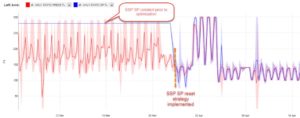Related Case Studies
Read more on how CopperTree Analytics is helping buildings all across the globe create energy savings, improve occupant comfort, and reduce energy consumption with Kaizen.
In recent years, Miramichi Regional Hospital’s Facilities, Engineering and Property Management staff have recognized the importance of energy efficiency while maintaining or improving the patient and staff experience of the communities they serve. Their exemplary maintenance practices and continuous improvement strategies coupled with their emphasis on energy efficiency has led to an exceptionally run facility. Since prioritizing energy efficiency, energy consumption of the facility has been reduced by 20% while maintaining occupant (patients and visitors) comfort and indoor air quality.
In many cases we see Kaizen being introduced as a means to improve building performance for inefficiently run buildings or facilities where it is known that positive improvements can be made. In other words, improvements are expected to be found when applying Kaizen to the facility. In this case, given the successes already achieved in energy reduction by the hospital, Kaizen was brought forward as the next step to improving upon the already efficiently-run facility.
Our challenges in implementing Kaizen were two-fold: we needed to show value in a product that was in the pilot phase of implementation with Horizon Health Network, and we were striving to find significant areas for improvement in a facility with an excellent track record in terms of maintenance and energy reduction.
The Miramichi Regional Hospital had a full suite of analytics applied to all major Air Handling Units as well as the central heating and cooling plants. This included an array of energy meters, fault detection and diagnostics (FDD) monitoring, and the implementation of multiple Key Performance Indicators (KPI). Additional Building Management System (BMS) infrastructure monitoring was also applied along with Kaizen’s Golden Standard program for the entire facility’s control system.
Kaizen was a valuable tool in proving that this facility was running as well as expected. Standard applied rules that monitor the most common areas where problems are typically found showed no significant room for improvement. However, Kaizen’s flexibility excelled. With Kaizen, we were able to analyze systems and subsequently build custom rules that brought out hidden areas for improvement.
One such example was the operation of newly installed Variable Speed (Frequency) Drives on all the major Air Handling Units. It was noted through advanced analysis, that these Variable Speed Drives were not being fully utilized in that their speed could be further lowered to achieve additional energy savings. The Supply Static Pressure Setpoint (SSP SP) on the Air Handling Units (AHU) was not being reset based on actual demand from the Variable Air Volume (VAV) boxes. It was also noted that some of the zones were operating at airflows higher than the airflow setpoints. Based on our findings, a new fan speed control strategy was recommended. The new strategy would continually monitor the actual demand for air flow from the VAVs, and if the VAV dampers are closing indicating that there is sufficient airflow, the SSP SP would be reduced.
The recommendation was first implemented on one of the AHUs as a proof of concept project. In Figure 1, the SSP SP was a constant prior to the optimization, and how the SSP SP resets based on actual demand from the VAVs, after the optimization strategy was implemented. For the measurement and verification phase of the new strategy, we used Kaizen’s flexibility to implement a near real-time solution that continually shows the cost savings from the date on which we implemented the new control strategy relative to a baseline. Return on Investment for this solution was an exceptional one month time frame. After realizing energy reductions from the first unit, the same strategy was implemented on two additional AHUs. When implemented on all the Air Handling Units, this strategy itself can avoid approximately $75,000 per year in energy costs. The hospital is now working on a plan to implement the new strategy on 12 additional AHUs.
As with most facilities, maintenance is performed on a limited budget, meaning that maintenance staff’s time is at a premium. Kaizen showed its benefit to Miramichi Regional Hospital building operators through its fault detection and diagnostics as well as its Golden Standard systems. Maintenance staff had performed troubleshooting and maintenance of hallway lighting that was controlled by the BMS. Due to the maintenance staff’s busy schedule and dealing with emergency maintenance issues, this lighting circuit that controlled a large area in the facility had been left manually turned on. The Kaizen reporting feature showed this to the operators the next time they logged into the system, several days later. At that point the lighting circuit was returned to automatic operation. Kaizen not only helped staff maintain a higher level of quality control in their facility but it also reduced energy due to the lighting circuit being returned to automatic operation so quickly.
